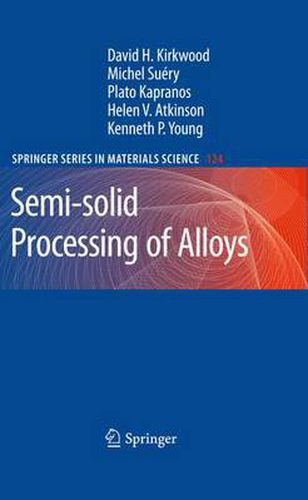Readings Newsletter
Become a Readings Member to make your shopping experience even easier.
Sign in or sign up for free!
You’re not far away from qualifying for FREE standard shipping within Australia
You’ve qualified for FREE standard shipping within Australia
The cart is loading…






This title is printed to order. This book may have been self-published. If so, we cannot guarantee the quality of the content. In the main most books will have gone through the editing process however some may not. We therefore suggest that you be aware of this before ordering this book. If in doubt check either the author or publisher’s details as we are unable to accept any returns unless they are faulty. Please contact us if you have any questions.
Semisolid metallurgy (SSM) is now some 37-years-old in terms of time from its conception and ?rst reduction to practice in the laboratory. In the intervening years, there has been a steadily growing body of research on the subject and the beginning of signi?cant industrial applications. The overall ?eld of SSM comprises today a large number of speci?c process routes, almost all of which fall in the category of either Rheocasting or Thi- casting. The former begins with liquid metal and involves agitation during partial solidi?cation followed by forming. The latter begins with solid metal of suitable structure and involves heating to the desired fraction solid and forming. Research over the past 37 years, and particularly over the last decade, has provided a detailed picture of process fundamentals and led to a wide range of speci?c SSM processes and process innovations. Industrial studies and actual p- duction experience are providing a growing picture of the process advantages and limitations. At this time, the conditions for eventual wide adoption of SSM appear favorable, both for nonferrous and ferrous alloys. It must, however, be recognized that major innovations, such as SSM become adopted only slowly by industries where capital costsarehigh,pro?tmarginsaremodest,andfailuretomeetcustomercommitments carries a high penalty.
$9.00 standard shipping within Australia
FREE standard shipping within Australia for orders over $100.00
Express & International shipping calculated at checkout
This title is printed to order. This book may have been self-published. If so, we cannot guarantee the quality of the content. In the main most books will have gone through the editing process however some may not. We therefore suggest that you be aware of this before ordering this book. If in doubt check either the author or publisher’s details as we are unable to accept any returns unless they are faulty. Please contact us if you have any questions.
Semisolid metallurgy (SSM) is now some 37-years-old in terms of time from its conception and ?rst reduction to practice in the laboratory. In the intervening years, there has been a steadily growing body of research on the subject and the beginning of signi?cant industrial applications. The overall ?eld of SSM comprises today a large number of speci?c process routes, almost all of which fall in the category of either Rheocasting or Thi- casting. The former begins with liquid metal and involves agitation during partial solidi?cation followed by forming. The latter begins with solid metal of suitable structure and involves heating to the desired fraction solid and forming. Research over the past 37 years, and particularly over the last decade, has provided a detailed picture of process fundamentals and led to a wide range of speci?c SSM processes and process innovations. Industrial studies and actual p- duction experience are providing a growing picture of the process advantages and limitations. At this time, the conditions for eventual wide adoption of SSM appear favorable, both for nonferrous and ferrous alloys. It must, however, be recognized that major innovations, such as SSM become adopted only slowly by industries where capital costsarehigh,pro?tmarginsaremodest,andfailuretomeetcustomercommitments carries a high penalty.